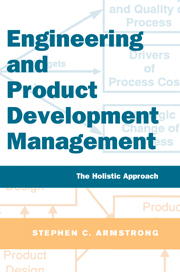Book contents
- Frontmatter
- Contents
- List of figures and tables
- Forewords
- Preface
- Acknowledgments
- Layout of book at a glance
- PART 1 UNDERSTANDING ENGINEERING PROCESS MANAGEMENT
- PART 2 APPLYING ENGINEERING PROCESSES TO PROGRAM MANAGEMENT
- 4 Roles and responsibilities
- 5 Approach to program and project management
- 6 An integrated team member's guide to performing a task
- 7 Program structuring and planning
- 8 Risk assessment
- 9 Program initiation and execution
- 10 Program reviews
- 11 Engineering change management and product data management
- PART 3 DEPLOYING ENGINEERING PROCESS MANAGEMENT
- PART 4 APPENDIXES
- Glossary
- References
- Index
6 - An integrated team member's guide to performing a task
Published online by Cambridge University Press: 05 April 2014
- Frontmatter
- Contents
- List of figures and tables
- Forewords
- Preface
- Acknowledgments
- Layout of book at a glance
- PART 1 UNDERSTANDING ENGINEERING PROCESS MANAGEMENT
- PART 2 APPLYING ENGINEERING PROCESSES TO PROGRAM MANAGEMENT
- 4 Roles and responsibilities
- 5 Approach to program and project management
- 6 An integrated team member's guide to performing a task
- 7 Program structuring and planning
- 8 Risk assessment
- 9 Program initiation and execution
- 10 Program reviews
- 11 Engineering change management and product data management
- PART 3 DEPLOYING ENGINEERING PROCESS MANAGEMENT
- PART 4 APPENDIXES
- Glossary
- References
- Index
Summary
This chapter is written specifically for the team member. It explains how the team member can use the documentation that supports the product development process to understand and perform the required work. Program and functional directors should read this chapter to understand the details of the process.
INTEGRATED PRODUCT TEAM MEMBER RESPONSIBILITIES
The program and functional directors will give IPT members various assignments from the project plan, and this chapter will show a team member how the process documentation helps to complete them. Understanding how the project plan is organized is critical to allowing a team member to find and assimilate quickly what he or she needs to know and how to complete an assignment.
PERFORMING A SPECIFIC TASK
Performing a specific task means doing work that contributes to the development of the customer's product. The program director bases the assignment of these tasks on the program plan and his or her judgment of how resources should be allocated. Because the program plan is developed from the workplan templates, most assigned tasks are described in the process documentation. Completing a task involves
❍ Understanding what the task involves, howit fits into the process integration framework, and to which customer deliverable it contributes
❍ Understanding the individual work products that result from completing the task
❍ Gathering the materials necessary to complete the task
❍ Performing the task
- Type
- Chapter
- Information
- Engineering and Product Development ManagementThe Holistic Approach, pp. 87 - 97Publisher: Cambridge University PressPrint publication year: 2001



